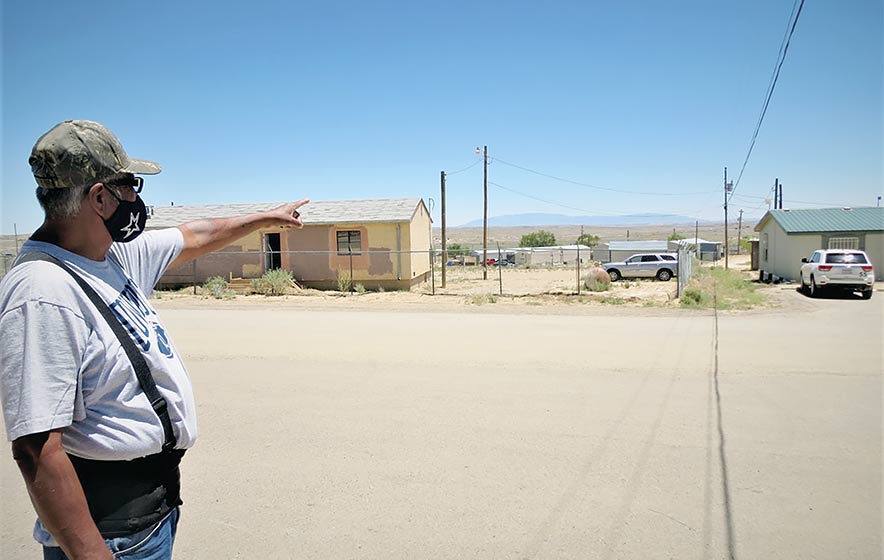
- Details
- By Levi Rickert
WINDOW ROCK, Ariz. — To’hajiilee, a Navajo Nation community with 2,500 residents, is in desperate need of safe drinking water. Located 24 miles west of Albuquerque, N.M., the community’s water supply problem has become exacerbated by the COVID-19 pandemic, as essential health and safety guidelines call for frequent hand washing and proper sanitization.
Last month, To’hajiilee Chapter President Mark Begay told the Navajo Times that the water in their community is “dirty” and “smells like rotten eggs.”
A To’hajiilee-Albuquerque water pipeline project was created to support the immediate and long-term water needs of the Navajo people of the To’hajiilee satellite community. The project calls for a pipeline to bring in fresh water from Albuquerque through a proposed 7.2-mile stretch.
Currently, the project is being blocked due to the non-responses of both Western Albuquerque Land Holdings (WALH) and the Garrett Development Corporation of Arizona (GDCA).
The Navajo Nation Council, local To’hajiilee Chapter government, Navajo community members and Navajo Nation Council Delegate Jamie Henio (Alamo, Ramah, Tohajiilee) are seeking immediate relief as critical local water wells are expected to go dry by year’s end.
“The Navajo people living in the To’hajiilee community desperately need a long-term, reliable water supply,” said Henio. “Without this important water pipeline project, To'hajiilee existing water wells will continue to fail after years of ‘band-aid’ fixes. Five have failed already, and the sixth has less than 11 months until it will also fail.”
U.S. Sen. Martin Heinrich has weighed in and is calling for a solution to help the project move beyond the roadblock by the private development companies.
“I find it unconscionable that Western Albuquerque Land Holdings and Garrett Development Corporation have been unwilling to come to the negotiating table to help the To’hajiilee Chapter secure access to clean water. This is truly a humanitarian crisis and we need a solution immediately,” Heinrich said on social media.
“The Navajo Nation Council has always fully supported the To’hajiilee-Albuquerque water pipeline project, and we have reached out to state and national leaders throughout this process to ensure their support, as well,” 24th Navajo Nation Council Speaker Seth Damon said. “This is the most viable option for a stable source of water for the To’hajiilee community, and we’re willing, as Navajo leaders, to work with any partner or private company to make sure it continues to move forward.”
“Unless these companies give us the opportunity to negotiate access through the property, when the last To’hajiilee community water well fails, Navajo families will have to resort to bringing in water with emergency tanker trucks,” Henio stated. “We call on the Navajo People and those beyond the Navajo Nation to help us bring these private companies to the table so that the people of the To’hajiilee community can have access to clean water. Time is of the essence.”
More Stories Like This
Native News Weekly (August 25, 2024): D.C. BriefsUS Presidents in Their Own Words Concerning American Indians
Native News Weekly (November 30, 2025): D.C. Briefs
Indigenous Actor Elaine Miles Reports Detention by Alleged ICE Agents
Happy Thanksgiving from Native News Online
Help us tell the stories that could save Native languages and food traditions
At a critical moment for Indian Country, Native News Online is embarking on our most ambitious reporting project yet: "Cultivating Culture," a three-year investigation into two forces shaping Native community survival—food sovereignty and language revitalization.
The devastating impact of COVID-19 accelerated the loss of Native elders and with them, irreplaceable cultural knowledge. Yet across tribal communities, innovative leaders are fighting back, reclaiming traditional food systems and breathing new life into Native languages. These aren't just cultural preservation efforts—they're powerful pathways to community health, healing, and resilience.
Our dedicated reporting team will spend three years documenting these stories through on-the-ground reporting in 18 tribal communities, producing over 200 in-depth stories, 18 podcast episodes, and multimedia content that amplifies Indigenous voices. We'll show policymakers, funders, and allies how cultural restoration directly impacts physical and mental wellness while celebrating successful models of sovereignty and self-determination.
This isn't corporate media parachuting into Indian Country for a quick story. This is sustained, relationship-based journalism by Native reporters who understand these communities. It's "Warrior Journalism"—fearless reporting that serves the 5.5 million readers who depend on us for news that mainstream media often ignores.
We need your help right now. While we've secured partial funding, we're still $450,000 short of our three-year budget. Our immediate goal is $25,000 this month to keep this critical work moving forward—funding reporter salaries, travel to remote communities, photography, and the deep reporting these stories deserve.
Every dollar directly supports Indigenous journalists telling Indigenous stories. Whether it's $5 or $50, your contribution ensures these vital narratives of resilience, innovation, and hope don't disappear into silence.
 The stakes couldn't be higher. Native languages are being lost at an alarming rate. Food insecurity plagues many tribal communities. But solutions are emerging, and these stories need to be told.
The stakes couldn't be higher. Native languages are being lost at an alarming rate. Food insecurity plagues many tribal communities. But solutions are emerging, and these stories need to be told.
Support independent Native journalism. Fund the stories that matter.
Levi Rickert (Potawatomi), Editor & Publisher

